Some people only sleep in one position – whether that’s on their side, on their back, or on their stomach. But some of us are more restless than others. If you’re what we call a combination sleeper, changing position often during the night, you’ll want a mattress that can not only cope with all the different ways you sleep, but allows you to move around easily (and without waking your partner).
If you spend most of your time in a single position, only changing position infrequently, you might pick the mattress for that sleeping position – try our reviews of mattresses for side sleepers, back sleepers and stomach sleepers. But in this article, we’ve looked at mattresses that are good for the more active combination sleeper, and which will give you adequate support and comfort whichever way you turn. If you’re looking for the best mattress for combo sleepers, you’re in the right place.
Best Mattress for Combination Sleepers In 2020
Casper Sleep Mattress – Best Overall
We’ve recommended Casper’s mattresses under other categories too, but we think it’s zoned support system makes it a particularly smart choice for combination sleepers.
This hybrid mattress comes in medium firmness – just a little on the ‘firm’ side of medium. It sits on a base of pocket coils, with four layers of foam on top, including a top breathable layer that should ensure the mattress doesn’t warm up too much. Beneath the breathable top is a layer of memory foam to provide pressure relief, and beneath that, the zoned support layer which lets your hips and shoulders sink in gently.
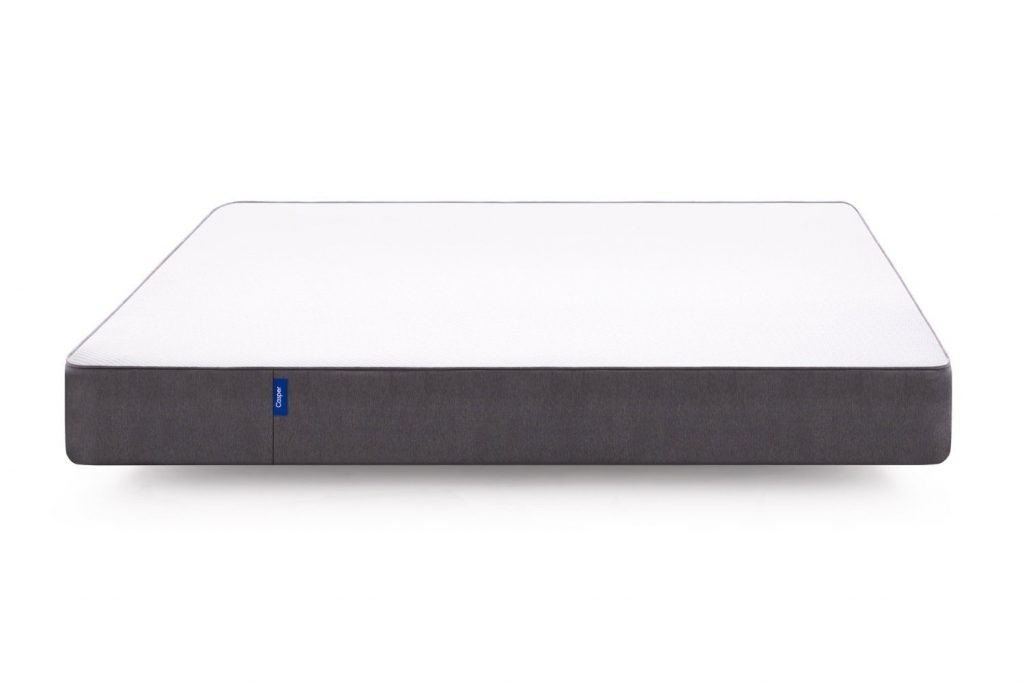
There’s firmer foam under the hips, where most of your weight goes, and less under your shoulders, so you need to get this mattress the right way around on your bed. It also has great edge support coming from specially made robust coils placed around the perimeter.
Casper offers a 100 night trial and a 10 year warranty, making this mattress worthy of our top pick.
Brooklyn Signature Mattress – Best Hybrid
This 11″ mattress is a good value option that’s available in firm, medium and soft options. While medium is the best for most combination sleepers, the firm is really a medium-firm, so if you prefer a harder surface, it might also make a good choice.
The mattress is a hybrid that uses a 6″ layer of pocketed coils – up to 1064 of them – on top of a 1% high density foam layer to provide a highly stable base that delivers a bit of bounce.
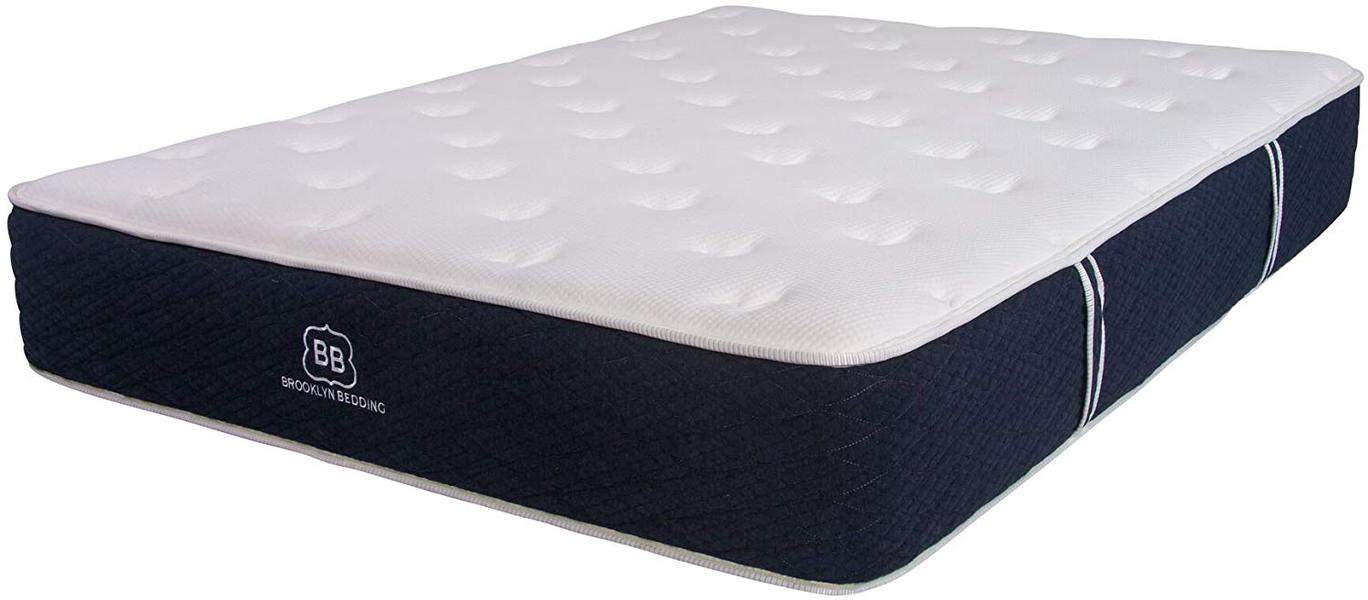
Above this, TitanFlex pressure relieving foam gives good body-contouring, while traditional Energex foam gives compression support. Finally, the top layer is gel-infused to diffuse heat away from the body and provide a cool sleep experience.
Also good to know is that this mattress is US made, and Certi-PUR US certified to contain no harmful chemicals.
It gives you many of the comfort advantages of memory foam, such as great cushioning for pressure points, but it doesn’t sleep deep and ‘hugging’ like memory foam.
Available with a lengthy sleep trial period and the option of returning the mattress for a full refund.
Luxi 3in1 Mattress – Best Customization
Luxi is a great choice for couples with a combination sleeper (or even two combination sleepers!), since it comes with dual side adjustability.
Each side of the mattress can be adjusted separately, ensuring partners with different preferences can each have their ideal mattress without having to make a compromise.The mattress is delivered as a medium, but the adjustable layers can be flipped to make the bed harder or softer.
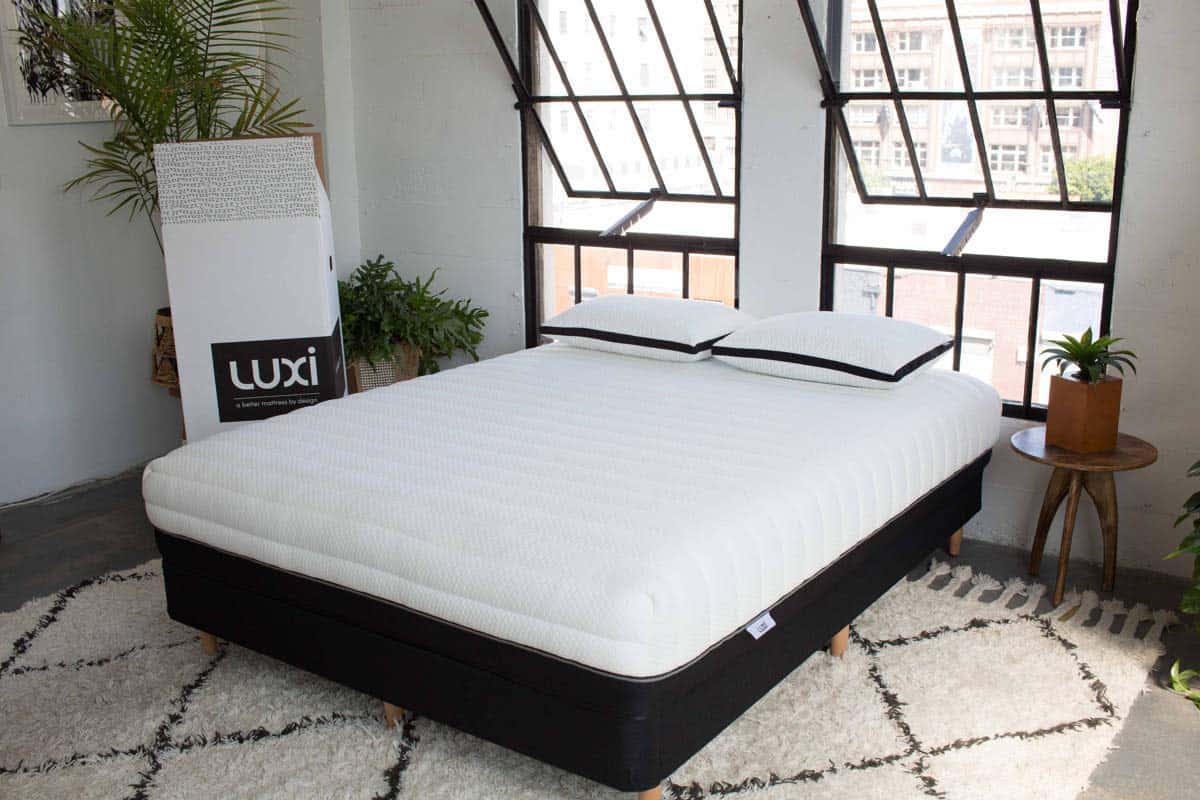
Luxi also has an unusual “shape-matching technology” in the form of a grid of mushroom shaped foam pillars which adjust to the body. It’s very simple when you look at it, but it’s a real innovation in the mattress space and gives great contouring – fantastic when you turn on your side.
The perfect choice for those who require more customization.
GhostBed Mattress – Best Memory Foam
Here’s another piece of new technology for combination sleepers! The Japanese formulated Ghost foam and fabric aim to provide a cooling Ice experience plus a definite bounce. 7 separate layers make up this 13″ mattress, which aims to combine the contouring and cushioning qualities of memory foam with the responsiveness of latex.
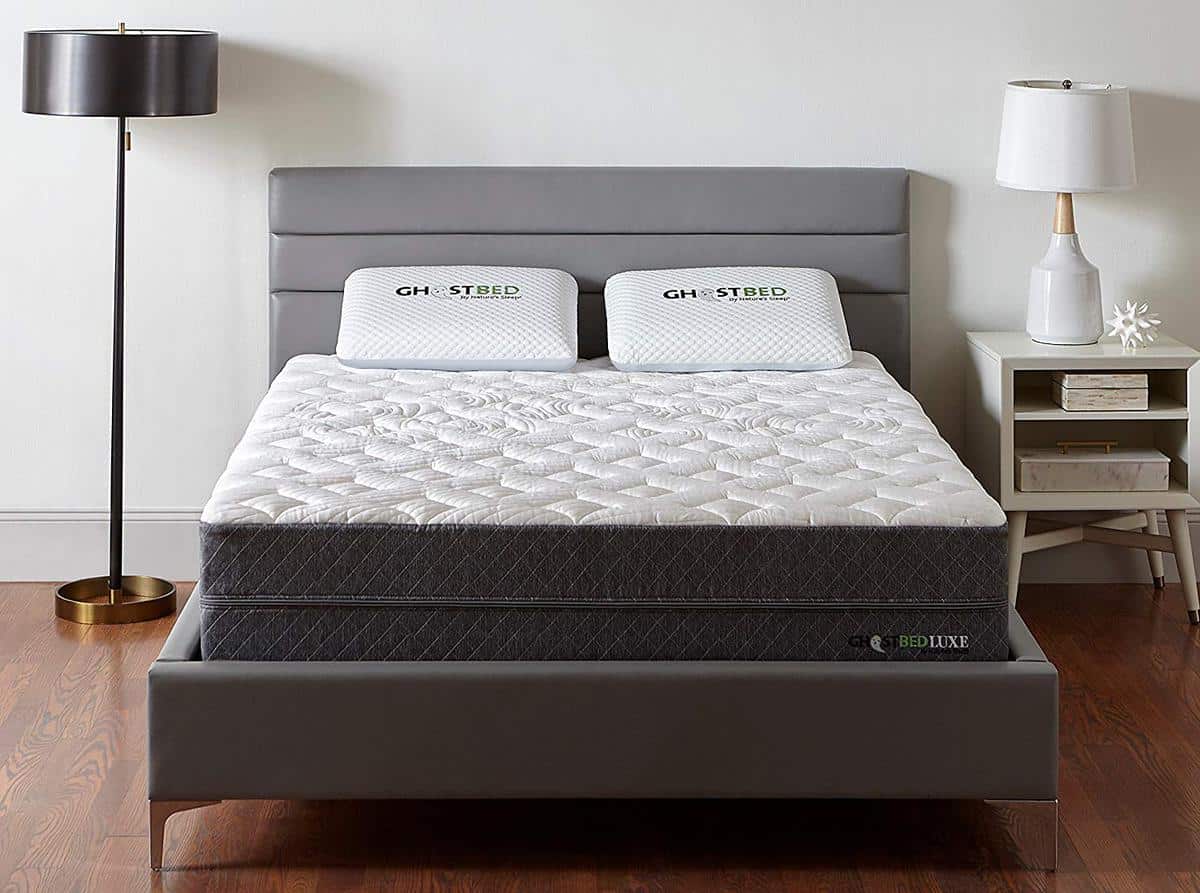
A huge advantage for combination sleepers is that latex lets you move around easily with the minimum resistance from your bed, while you also get really good motion isolation.
We’d say this bed is just slightly on the firm side of medium, coming in around 6 on the scale. It sleeps without the hugging feel of foam and it also has great cooling, as evidenced by many positive customer reviews – as well as a Sleep Award from Men’s Health magazine.
On the downside, GhostBed is a little expensive and edge support is poor, as it often is with foam and latex mattresses.
GhostBed offers a 100 night trial on all Amazon products, with free returns, plus an amazing 25 year warranty.
Nectar Mattress – Best Value for Money
We make no apologies for listing Nectar yet again as a choice for combination sleepers.
Nectar really do a great job of producing best-selling high comfort mattresses at an affordable price point. It even includes two free premium pillows with your order. No wonder its mattresses are best sellers!
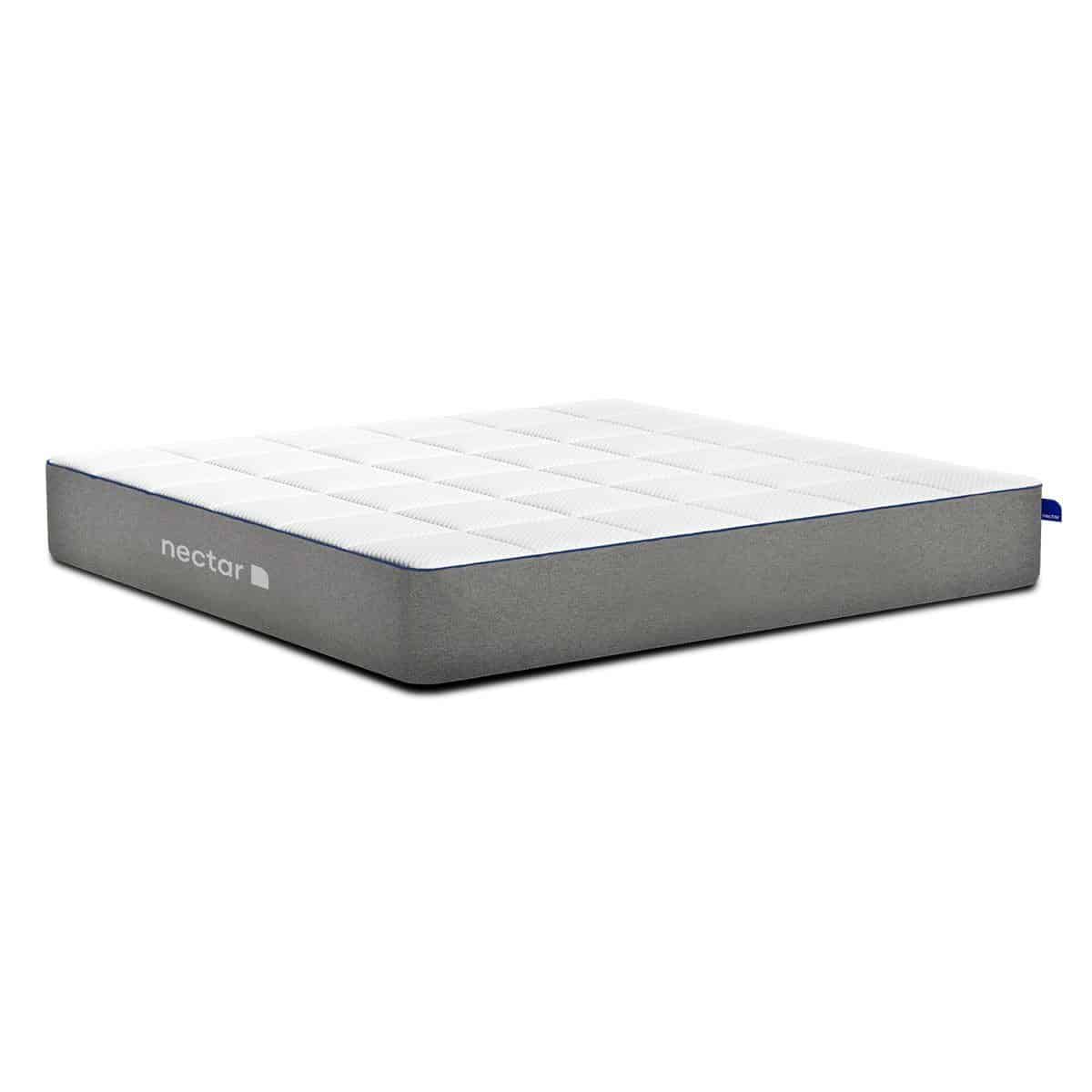
This memory foam mattress has two layers of gel-infused memory foam over a high-density base, delivering both good body conforming and coolness. A Tencel cooling cover also helps this mattress sleep cooler than you’d expect from memory foam.
This mattress seems to have hit the Goldilocks sweet spot – not too soft and not too hard! It’s particularly good for sleepers with chronic pain or back problems, with excellent user reviews.
However like many memory foam mattresses, it does ‘hug’ you a bit which you might not like and it doesn’t have great edge stability.
Nectar offers a 180 night sleep trial as well as a Nectar Forever warranty that lasts as long as you own the mattress.
Combo Sleeper Mattress Buyer’s Guide
The single most important factor when you’re looking at a mattress is that it will maintain proper spinal alignment so that your backbone is properly supported. If you sleep in just one position, that’s easy – less so if you are a combination sleeper and like to switch sleep position (known as combination sleeping). A mattress that’s firm and positive for a back sleeper might be too hard for a side sleeper who needs their hips and shoulders to sink in a little to maintain that alignment. A good mattress for a side sleeper could be way too body-hugging for a front sleeper. So to some extent, a good mattress for a combination sleeper is a compromise.
You’ll want support that keeps your spine in its proper alignment whichever way up you’re sleeping. You’ll want a mattress that has a fast response so that it doesn’t resist when you want to turn over. And you’ll want good motion transfer isolation too.
However, there are a few other factors you’ll definitely want to consider. For instance, some memory foam beds allow sleepers to sink in quite deeply. That’s great for confirmed side sleepers, but bad news if you move during the night, as the mattress will present some resistance and you may even wake up struggling and feeling confined. So a good mattress for a combi sleeper should keep a relatively even surface.
Combination sleepers really need an adaptive mattress – and thankfully there are quite a few interesting possibilities out there. When once you only had a choice between memory foam (too hot, too much ‘give’) and innerspring (no ‘give’ at all, and noisy), now you have a wide choice of different hybrid and multi-foam mattresses as well as latex.
Are you a side sleeper? Our side sleeper mattress guide is for you.
Pros & Cons of Each Sleeping Position
As a combo sleeper, you are able to benefit from the advantages provided by several sleeping positions without too many of the negatives. Repeatedly switching position, from back to side sleeping for example helps improve your circulation. Switching position can also help to reduce and prevent the numbness and pain that many Americans suffer from when they wake up in the morning.
Providing you’re not constantly tossing and turning throughout the night, you’re almost always better off as a mixed sleeper than as a static sleeper. Each position has distinct benefits as well as some disadvantages. This is what we’ve concluded through our research:
Side Sleeping
Pros:
- Provides better spine and pelvis alignment
- Reduces snoring
- Sleeping on the left side of your body aids in digestion, detoxification and also helps to prevent heartburn and acid reflux
- Very comfortable
- Great for spooning if you sleep with a partner
Cons:
- Could cause facial wrinkles
- Numbness can occur in the arms
- Could exacerbate a shoulder injury
Back Sleeping
Pros:
- Provides a neutral and natural position for the spine and neck
- Prevents you from twisting and turning into harmful positions
- Reduces facial wrinkles
Cons:
- May Increase snoring
- Exacerbates sleep apnea and other respiratory conditions
Stomach Sleeping
Pros:
- May reduce snoring
Cons:
- Could place the spine into an unnatural position
- Increased risk of stiffness and pain, especially in the neck
- The risk of lower back pain is increased
- May promote facial wrinkles
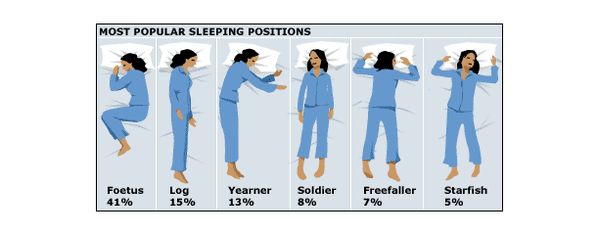
What Features Are Important for Combination Sleepers?
For combo sleepers, you need to remember that this type of mattress might be too soft for those occasions when you roll over onto your back or stomach. It is for this reason that a mattress that has the perfect blend of softness and support is recommended. We’ve provided guidance on each mattress type when you’re shopping as a multiple position sleeper.
Materials
Memory foam is great for side sleepers but can make it difficult for you if you enjoy rolling around. Latex offers firmer support with a quicker response for active sleepers. You might prefer an innerspring mattress – great for active sleepers, as you won’t struggle to move around. However, innerspring doesn’t always provide the best support for side sleepers. A hybrid mattress – foam or latex over an innerspring base – offers the best of both worlds.
Memory Foam
Memory foam mattresses became available in the 90s under the Tempur-Pedic brand name. They also came with a significant price tag to match. 30 years later and memory foam is now the most popular type of mattress available. It’s also far more affordable too (especially if you buy online), with this material receiving the highest satisfaction ratings with US consumers.
Many of us are familiar with the lasting imprint that is made when weight is placed onto a memory foam mattress. This is easily demonstrated by taking your hand and pressing it into the surface. Once you take it away, the imprint of your hand will remain there for a considerable amount of time.
This creates a soft and cuddly feeling bed that hugs your body while you sleep.
This sounds like a dream for side sleepers but it can be problematic for those who toss and turn during the night. This is because memory foam has a slow response time by nature.
If you’re the type of person who moves around a lot in bed, you’ll notice that you can’t roll over as easily as you would on other types of bed. This of course does vary by brand and model. You might notice you wake up more easily as you shift your body weight around. The knock on effect is a poorer quality of sleep.
Hybrid
Hybrid mattresses are often more suitable for multiple position sleepers. The trick to this superior performance is in the mix of materials that are used in hybrid beds. As an example, this type of bed combines multiple layers which often include a coil core which is combined with foam or latex comfort layers.
Some of the more luxurious mattress brands allow you to design and build a “custom” bed. You’re required to answer several questions about your typical sleeping habits and your favorite positions as well as your gender and weight. Once they have the information they need, they’ll design a mattress based upon your unique sleeper profile.
It’s even possible to customize some hybrid beds by selecting different materials in different locations. Perfect if you sleep with a partner who has different sleeping preferences.
Coil
A coil or innerspring mattress is made from springs that support your weight as you lie down. The best of these beds feature individual pocket coils that adapt to the differences in weight and body composition across your body.
If you’re classed as a combo, stomach or back sleeper, a coil mattress might be the best choice for you. If instead you sleep on your side during the night, some of these mattress types may be less comfortable for you. This is why it’s so important to find out how each product performs in every position.
Any bed made from a continuous coil construction could be at risk from sagging after a couple years of use. If this happens, each of your sleeping positions will be uncomfortable.
Here’s our list of top rated innerspring beds if you want to take a further look at this option.
Latex
This type of bed is commonly a great choice for combo sleepers because they naturally feature a springy bounce. This is combined with superior compression ability when your weight is applied across the surface, allowing the mattress to support your curves without making you feel as if you’re stuck in the bed.
This type of bed is also available in all-natural latex. These are sourced from the sap of a rubber tree and made using the Dunlop or Talalay process. This option isn’t cheap and is one of the more expensive types of mattress you can buy there are cheaper alternatives which combine natural and synthetic components.
Zoned Support
You don’t need the same level of support and conforming everywhere. You’ll need a little more conforming around the shoulders and hips, and a zoned mattress can give you this while offering firm support for the rest of your body.
Fast Response
You’ll want a mattress that can keep up with your moving around. Memory foam can be slow to spring back, and if you’ve sunk in quite deeply you may find yourself feeling as if you’re lying in a hole that you have to climb out of. Latex and innerspring, on the other hand, will quickly adapt to your new position.
This is particularly important in larger bed sizes such as queens and kings.
Firmness
Unless you’re primarily a side sleeper, you’ll probably want a medium to firm mattress. That will help you move about on the mattress, too. If you’re a heavier person (say 230lbs or more) you can add a little extra firmness to the equation (maybe move from 5-6 to 7-8 on the scale), while if you weigh in at under 130lbs, you might prefer a softer mattress.
Sleep Temperature
If you sleep hot, you’ll probably prefer an innerspring, latex or hybrid mattress, as foam mattresses can store body heat and prove uncomfortably warm. However, some foam mattresses are now using gel-infused foams or natural material tops to help diffuse that heat and give customers a cooler sleep experience.
Motion Isolation
Motion isolation is definitely a consideration for the more active sleeper whose partner complains about their sleeping habits. This is where memory foam does well – but so does latex, which offers you more positive support. Innerspring mattresses can be noisy and too responsive to movement, though hybrid mattresses seem to have managed to tame this aspect of innerspring coils.
Couples
Compromise may be necessary if you have a partner with a different sleeping style or different preferences. Hybrid mattresses and medium firmness levels are probably best for those who have to compromise. Alternatively, consider the Luxi 3-in-1, which can be adjusted with separate firmness settings for each side of the bed – then you can both be happy. Get a mattress with good motion isolation, too, so you don’t wake each other up whenever you turn over.
Sleep Trials
Sleep trials are offered by most vendors and can help take the risk out of your buying decision. Typically, you’ll be able to try the mattress out for 90-180 nights and return it if you’re dissatisfied. Look for vendors which offer a free pickup or a charity donation opportunity. Note that some vendors insist on a minimum period to ensure you’ve given the mattress a fair chance.
Warranties
Having a good warranty is important. While the mattresses we’ve chosen are durable, occasionally there may be a manufacturer defect which might not become apparent for a while. You’ll want to be well covered. The industry standard is 10 years, but some manufacturers offer a lifetime guarantee that lasts as long as you own the mattress. Check the small print to see how long the 100% cover lasts – most warranties only offer a prorated percentage payback after the first few years, to take account of wear and tear.
Budget
Price is obviously important. While you can buy a mattress for as little as $100, few brands provide good quality much below $500-1,000. Above that level, you’re looking at specialized or high-tech luxury mattresses – which may be worth it, if that’s what it takes to get you a good night’s sleep. Remember to check out shipping costs and whether you have to pay any state taxes.
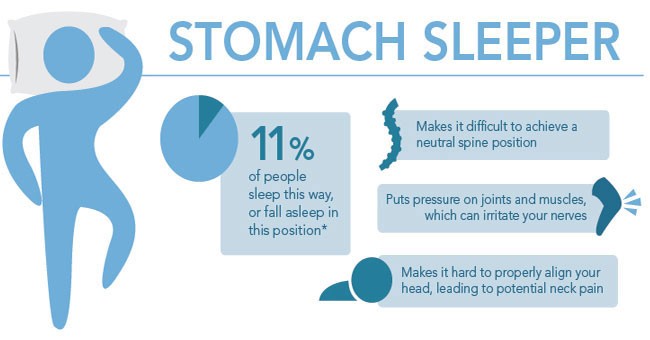
Final Verdict
We’ve looked at loads of mattresses. We’ve tested several of them. We’ve read users’ reviews, too – because we think the real experts are the people who sleep on these mattresses, not the people who make them. And we’ve found out five mattresses that give combination sleepers just the right combination of qualities.
Remember, buying a good mattress is an investment in your own relaxation and good health. Buy the wrong mattress, and your back will tell you all about it – maybe not today, maybe not tomorrow, but in a few years’ time. And chronic back pain is something you really don’t want to know about.
Like any investment, buying a mattress deserves careful consideration. Do your research, track user reviews, and find out as much as you can about the various mattresses before you make your choice. If there’s a sleep trial available, use it, and feel free to return a mattress if you’re feeling twinges or getting up feeling achy in the morning. Once you find the right mattress, you’ll know – you’ll get a good night’s rest, and you’ll wake up feeling a million dollars in the morning.